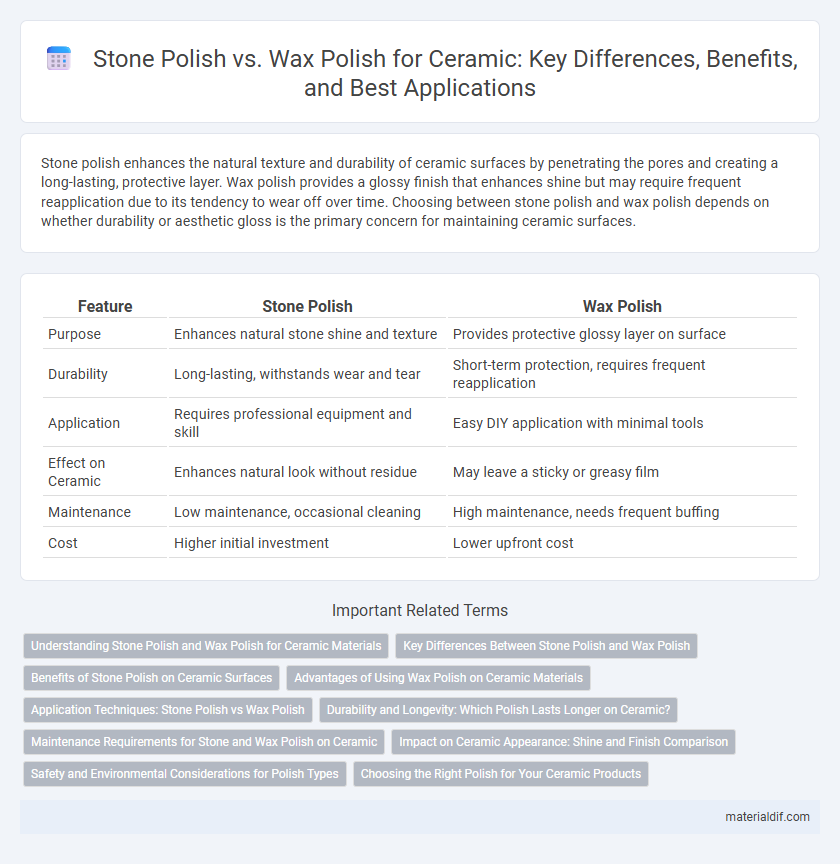Stone polish enhances the natural texture and durability of ceramic surfaces by penetrating the pores and creating a long-lasting, protective layer. Wax polish provides a glossy finish that enhances shine but may require frequent reapplication due to its tendency to wear off over time. Choosing between stone polish and wax polish depends on whether durability or aesthetic gloss is the primary concern for maintaining ceramic surfaces.
Table of Comparison
| Feature | Stone Polish | Wax Polish |
|---|---|---|
| Purpose | Enhances natural stone shine and texture | Provides protective glossy layer on surface |
| Durability | Long-lasting, withstands wear and tear | Short-term protection, requires frequent reapplication |
| Application | Requires professional equipment and skill | Easy DIY application with minimal tools |
| Effect on Ceramic | Enhances natural look without residue | May leave a sticky or greasy film |
| Maintenance | Low maintenance, occasional cleaning | High maintenance, needs frequent buffing |
| Cost | Higher initial investment | Lower upfront cost |
Understanding Stone Polish and Wax Polish for Ceramic Materials
Stone polish enhances ceramic surfaces by filling microscopic pores and creating a durable, natural-looking shine that resists wear and staining. Wax polish forms a protective layer on ceramics, offering short-term gloss and water resistance but requiring frequent reapplication due to its softer composition. Choosing between stone polish and wax polish depends on desired durability, maintenance frequency, and the specific ceramic material's porosity and finish.
Key Differences Between Stone Polish and Wax Polish
Stone polish enhances the natural texture and color of stone surfaces by penetrating the material and creating a long-lasting, matte or glossy finish, whereas wax polish forms a protective, water-resistant layer that sits on top of the surface, providing temporary shine and protection. Stone polish is ideal for porous stones like marble and granite, offering durability and resistance to stains, while wax polish requires frequent reapplication and can build up over time, potentially dulling the appearance. The choice between stone polish and wax polish depends on the desired finish, maintenance routine, and type of ceramic or stone surface.
Benefits of Stone Polish on Ceramic Surfaces
Stone polish on ceramic surfaces enhances durability by creating a hard, protective layer that resists scratches and stains more effectively than wax polish. It penetrates the ceramic pores, improving the surface's resistance to water and chemicals while maintaining a natural, glossy finish. Unlike wax polish, stone polish requires less frequent reapplication, providing long-lasting shine and easier maintenance.
Advantages of Using Wax Polish on Ceramic Materials
Wax polish on ceramic materials provides a durable protective layer that enhances resistance to stains, scratches, and moisture damage. It creates a glossy finish that highlights the natural texture and color variations of ceramics while maintaining a non-toxic, eco-friendly composition. Regular application of wax polish prolongs the lifespan of ceramic surfaces by preventing surface dullness and simplifying cleaning processes.
Application Techniques: Stone Polish vs Wax Polish
Stone polish requires applying with a damp cloth followed by buffing to enhance the natural texture and shine of ceramic surfaces, making it ideal for restoring worn stone finishes. Wax polish involves spreading a thin, even layer using a soft cloth or applicator pad, then allowing it to dry before buffing to provide a protective, glossy coating that repels water and dirt. Proper application of stone polish maintains breathability in porous ceramic tiles, while wax polish adds surface protection but may require frequent reapplication to avoid buildup.
Durability and Longevity: Which Polish Lasts Longer on Ceramic?
Stone polish on ceramic surfaces offers superior durability and longevity compared to wax polish, as its mineral-based composition creates a harder, more resilient coating that withstands scratches and wear. Wax polish, while providing a glossy finish, tends to wear off faster due to its softer, synthetic makeup, requiring more frequent reapplications. For ceramic tiles subjected to heavy traffic or outdoor conditions, stone polish remains effective for months longer than wax polish, making it a preferred choice for lasting protection.
Maintenance Requirements for Stone and Wax Polish on Ceramic
Stone polish on ceramic surfaces requires less frequent reapplication, maintaining a durable protective layer that resists stains and scratches effectively. Wax polish demands more regular upkeep, as it can wear off quickly, leaving the ceramic vulnerable to damage and requiring consistent buffing to restore shine. Proper maintenance of stone polish prolongs the longevity of ceramic finishes, while wax polish maintenance involves routine cleaning and reapplication to preserve surface aesthetics.
Impact on Ceramic Appearance: Shine and Finish Comparison
Stone polish creates a durable, natural-looking shine on ceramic surfaces, enhancing the stone's texture while maintaining its matte or semi-gloss finish. Wax polish imparts a glossier, more reflective surface, but can build up over time, potentially dulling the ceramic's original appearance. Choosing between stone polish and wax polish depends on the desired balance between long-lasting protection and a high-gloss finish on ceramic tiles or countertops.
Safety and Environmental Considerations for Polish Types
Stone polish typically contains natural minerals and is non-toxic, making it safer for both users and the environment compared to wax polish, which often includes synthetic chemicals and solvents that can emit harmful VOCs. Wax polish may create a slick surface that poses a slip hazard, especially in wet conditions, while stone polish enhances natural texture, reducing slippery risks. Biodegradability and low chemical runoff from stone polish contribute to eco-friendly maintenance of ceramic surfaces, aligning with sustainable cleaning practices.
Choosing the Right Polish for Your Ceramic Products
Stone polish enhances the natural texture and durability of ceramic surfaces by penetrating deeply to protect against stains and wear, while wax polish provides a glossy finish that temporarily shields against moisture and scratches. Selecting the right polish depends on the ceramic item's usage, with stone polish suited for high-traffic or exterior ceramics needing long-lasting protection and wax polish ideal for decorative pieces requiring frequent reapplication for shine. Understanding these differences ensures optimal maintenance, preserving both the aesthetic appeal and lifespan of ceramic products.
Stone Polish vs Wax Polish Infographic

 materialdif.com
materialdif.com